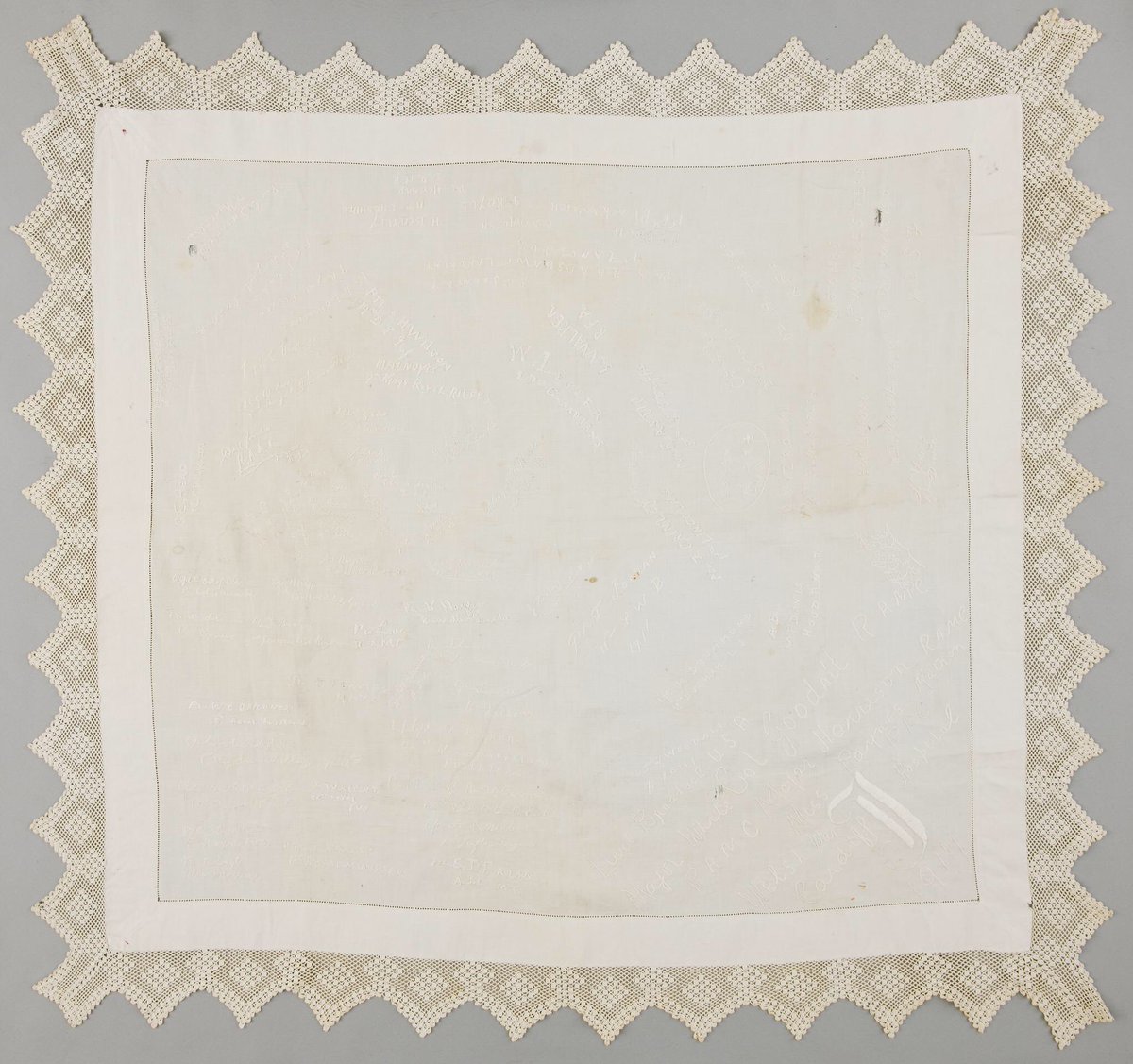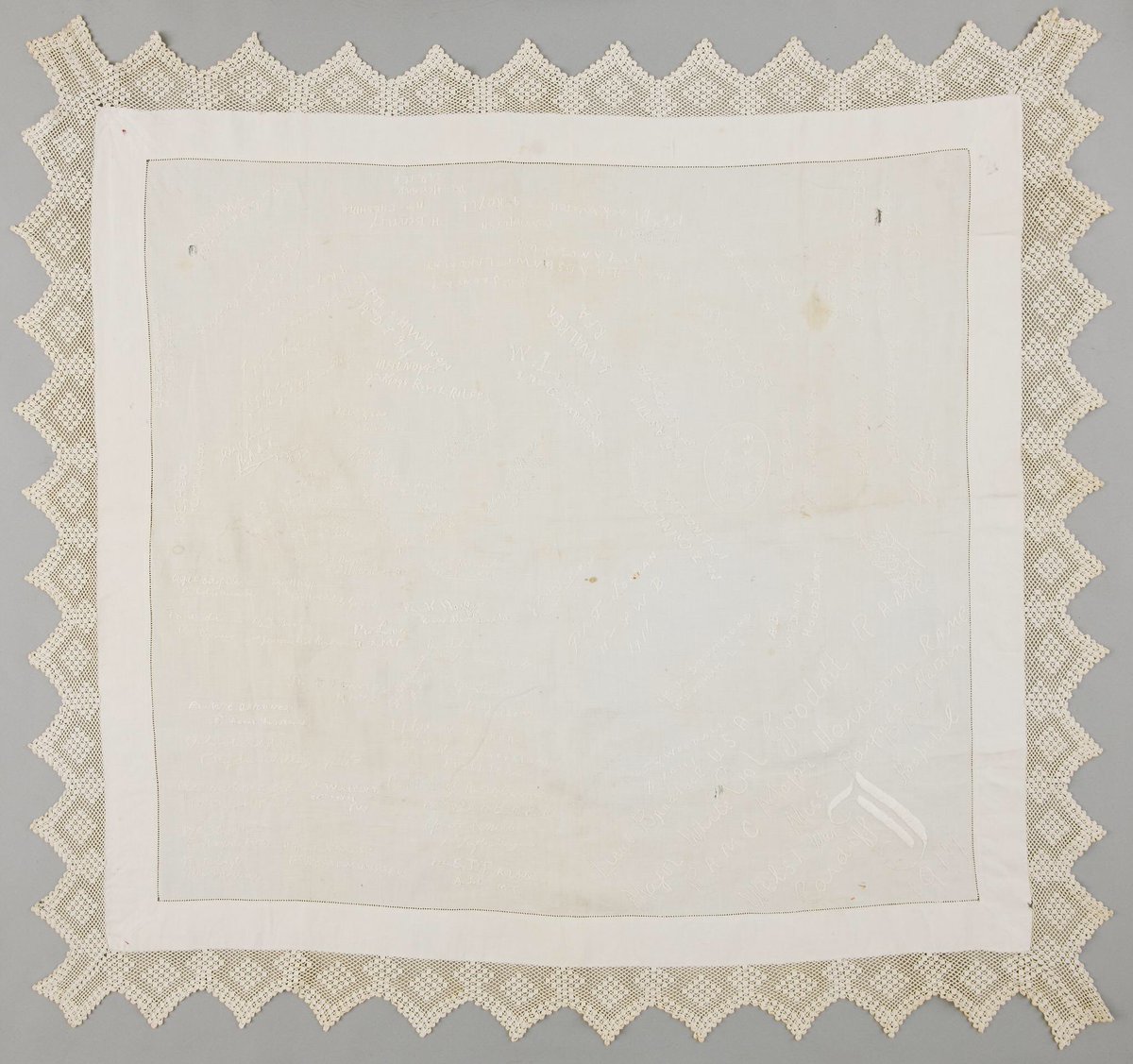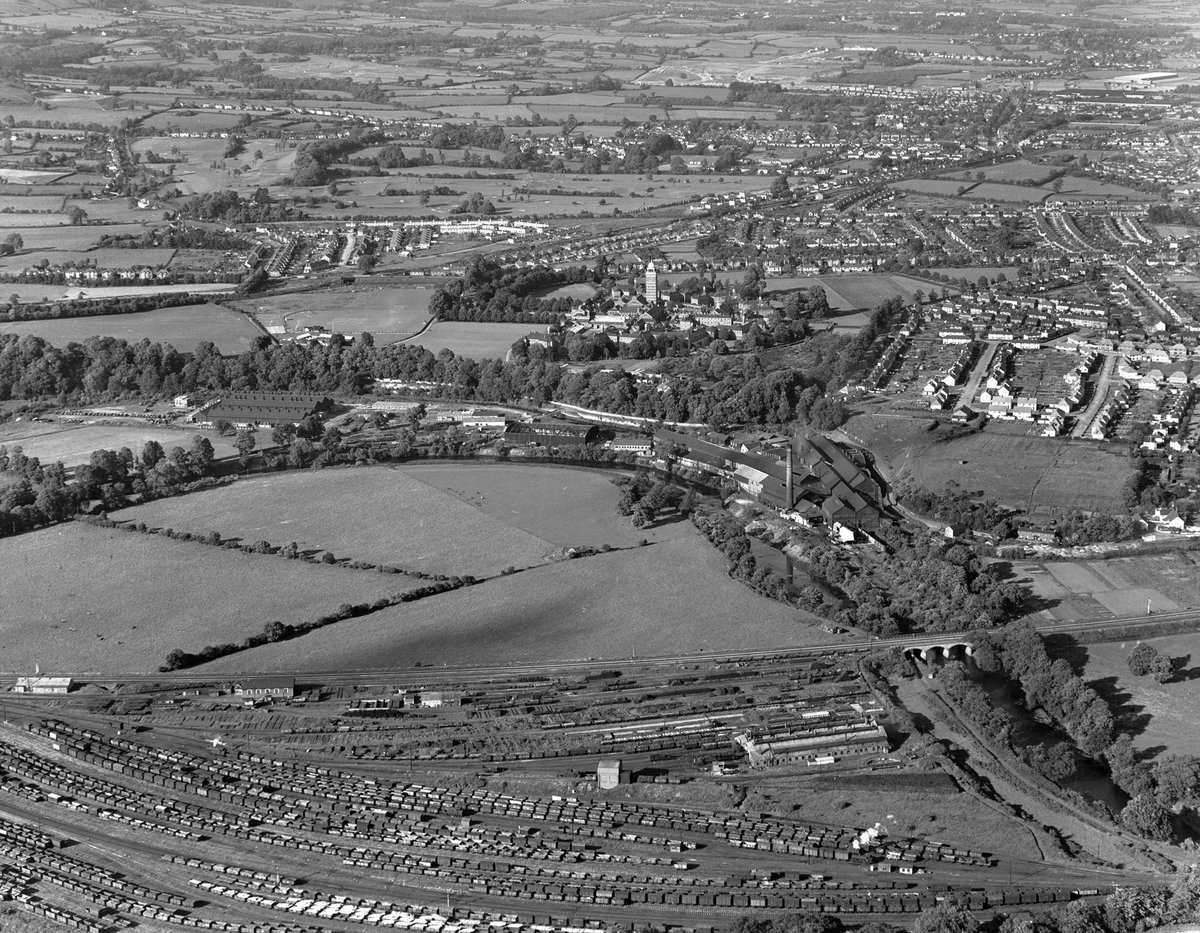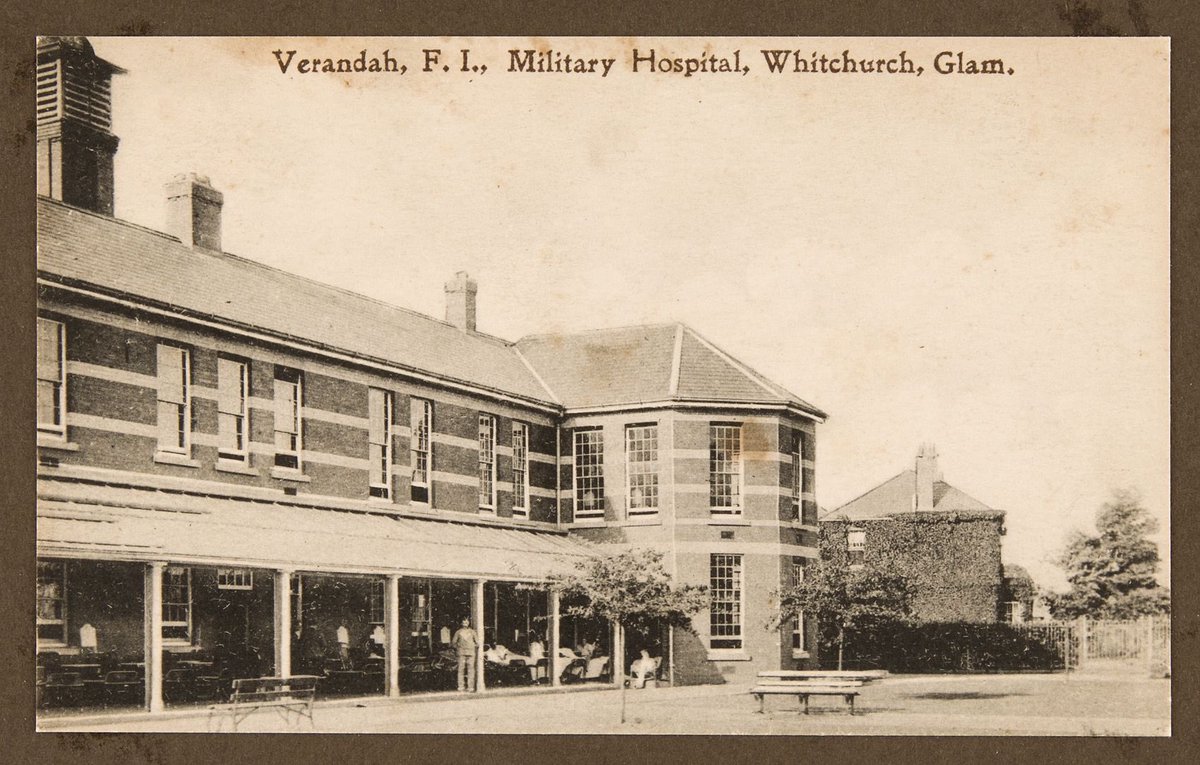The Whitchurch Hospital tablecloth, 1917 - a very brief history
#objectstories #materialculture
#MuseumFromHome
#WorldHealthDay https://abs.twimg.com/hashflags... draggable="false" alt="">
https://abs.twimg.com/hashflags... draggable="false" alt="">
A thread https://abs.twimg.com/emoji/v2/... draggable="false" alt="🧵" title="Thread" aria-label="Emoji: Thread">
https://abs.twimg.com/emoji/v2/... draggable="false" alt="🧵" title="Thread" aria-label="Emoji: Thread">
#objectstories #materialculture
#MuseumFromHome
#WorldHealthDay
A thread
OK - let& #39;s be honest. It& #39;s not the most & #39;instagramable& #39; textile in the collection.
A simple white cotton tablecloth with a crocheted border.
But this unassuming tablecloth contains a multitude of stories - both of local and national significance.
A simple white cotton tablecloth with a crocheted border.
But this unassuming tablecloth contains a multitude of stories - both of local and national significance.
It& #39;s a springboard to explore a range of subject areas:
Disability history #dishist
Mental health and psychiatry
Occupational therapy
Nursing and care giving
Craft and wellbeing
To list but a few.
#ObjectsMatter
Disability history #dishist
Mental health and psychiatry
Occupational therapy
Nursing and care giving
Craft and wellbeing
To list but a few.
#ObjectsMatter
Look closely at the tablecloth and you& #39;ll see names embroidered in white thread across the entire surface.
These are the signatures of a group of patients and staff at the Welsh Metropolitan War Hospital, Whitchurch, Cardiff in 1917.
https://museum.wales/collections/online/object/56dbebdb-6fcd-3189-a50d-1f11d5e70f65/Table-cloth/?field0=with_images&value0=1&field1=string&value1=Whitchurch&field2=string&value2=Hospital&index=1">https://museum.wales/collectio...
These are the signatures of a group of patients and staff at the Welsh Metropolitan War Hospital, Whitchurch, Cardiff in 1917.
https://museum.wales/collections/online/object/56dbebdb-6fcd-3189-a50d-1f11d5e70f65/Table-cloth/?field0=with_images&value0=1&field1=string&value1=Whitchurch&field2=string&value2=Hospital&index=1">https://museum.wales/collectio...
The Cardiff City Mental Hospital in Whitchurch opened in 1908.
During WW1 it was ceded to the military and became known as the Welsh Metropolitan War Hospital (1915-19).
Civilian patients moved out; injured soldiers moved in.
 https://abs.twimg.com/emoji/v2/... draggable="false" alt="📸" title="Camera with flash" aria-label="Emoji: Camera with flash"> H. Tempest Ltd
https://abs.twimg.com/emoji/v2/... draggable="false" alt="📸" title="Camera with flash" aria-label="Emoji: Camera with flash"> H. Tempest Ltd
https://museum.wales/collections/online/object/e09c35f1-f7b0-3c2d-ba36-3377de424c4e/Whitchurch-Hospital-Cardiff-negative/?field0=with_images&value0=1&field1=string&value1=Whitchurch&field2=string&value2=Hospital&index=0">https://museum.wales/collectio...
During WW1 it was ceded to the military and became known as the Welsh Metropolitan War Hospital (1915-19).
Civilian patients moved out; injured soldiers moved in.
https://museum.wales/collections/online/object/e09c35f1-f7b0-3c2d-ba36-3377de424c4e/Whitchurch-Hospital-Cardiff-negative/?field0=with_images&value0=1&field1=string&value1=Whitchurch&field2=string&value2=Hospital&index=0">https://museum.wales/collectio...
Initially, the hospital took in general cases, but from 1917 onwards it specialised in shell-shock and orthopaedic patients.
 https://abs.twimg.com/emoji/v2/... draggable="false" alt="📕" title="Closed book" aria-label="Emoji: Closed book">Borsay & Dale (eds), Mental Health Nursing, 2015.
https://abs.twimg.com/emoji/v2/... draggable="false" alt="📕" title="Closed book" aria-label="Emoji: Closed book">Borsay & Dale (eds), Mental Health Nursing, 2015.
 https://abs.twimg.com/emoji/v2/... draggable="false" alt="📸" title="Camera with flash" aria-label="Emoji: Camera with flash"> Postcard, Welsh Metropolitan War Hospital
https://abs.twimg.com/emoji/v2/... draggable="false" alt="📸" title="Camera with flash" aria-label="Emoji: Camera with flash"> Postcard, Welsh Metropolitan War Hospital
Back to the cloth.
The embroidered names include two important figures in the history of psychiatric care in Wales:
1. Dr Edwin Goodall - first Medical Superintendent of Whitchurch.
He received a CBE in 1919 for his treatment of shell-shock.
 https://abs.twimg.com/emoji/v2/... draggable="false" alt="🖥" title="Desktop computer" aria-label="Emoji: Desktop computer"> http://whitchurchhospital.co.uk/?p=793 ">https://whitchurchhospital.co.uk/...
https://abs.twimg.com/emoji/v2/... draggable="false" alt="🖥" title="Desktop computer" aria-label="Emoji: Desktop computer"> http://whitchurchhospital.co.uk/?p=793 ">https://whitchurchhospital.co.uk/...
The embroidered names include two important figures in the history of psychiatric care in Wales:
1. Dr Edwin Goodall - first Medical Superintendent of Whitchurch.
He received a CBE in 1919 for his treatment of shell-shock.
2. Matron Florence Raynes
She was the first woman to be in charge of the entire nursing staff at Whitchurch - nurses and male attendants and orderlies.
She was the first woman to be in charge of the entire nursing staff at Whitchurch - nurses and male attendants and orderlies.
A few years ago - during the #WW1 centenary commemorations - Jan Mogan from @WhitchurchHosp researched some of the soldiers named on the cloth.
Walter Charles Gardiner, 8th Btn, Royal Fusiliers
Patient at Whitchurch between 8 August 1916 - 27 June 1917.
He suffered from trench foot, and also had five fingers amputated.
Patient at Whitchurch between 8 August 1916 - 27 June 1917.
He suffered from trench foot, and also had five fingers amputated.
Albert Ernest Mildren, 1st Rifle Brigade
He had toes on both feet aputated as a result of frostbite and gangrene.
For more on Whitchurch Hospital during #WW1 https://abs.twimg.com/emoji/v2/... draggable="false" alt="👉" title="Right pointing backhand index" aria-label="Emoji: Right pointing backhand index"> http://whitchurchhospital.co.uk/?p=186 ">https://whitchurchhospital.co.uk/...
https://abs.twimg.com/emoji/v2/... draggable="false" alt="👉" title="Right pointing backhand index" aria-label="Emoji: Right pointing backhand index"> http://whitchurchhospital.co.uk/?p=186 ">https://whitchurchhospital.co.uk/...
He had toes on both feet aputated as a result of frostbite and gangrene.
For more on Whitchurch Hospital during #WW1
So why was the cloth made?
Could it have been a gift for a staff member - perhaps a nurse?
Was it made as an autograph & #39;book& #39; to be kept as a souvenir? A memento of a moment in time?
Or was it made as a form of occupational therapy for the soldiers?
It& #39;s a mystery.
Could it have been a gift for a staff member - perhaps a nurse?
Was it made as an autograph & #39;book& #39; to be kept as a souvenir? A memento of a moment in time?
Or was it made as a form of occupational therapy for the soldiers?
It& #39;s a mystery.
In the early 1980s, the cloth was purchased in a Cardiff antique centre by Ray Holman - now a leading costume designer for TV and film.
Ray generously donated the cloth to @StFagans_Museum in 2014.
An ordinary object with an extraordinary story to tell https://abs.twimg.com/emoji/v2/... draggable="false" alt="❤️" title="Red heart" aria-label="Emoji: Red heart">
https://abs.twimg.com/emoji/v2/... draggable="false" alt="❤️" title="Red heart" aria-label="Emoji: Red heart">
Ray generously donated the cloth to @StFagans_Museum in 2014.
An ordinary object with an extraordinary story to tell
With huge thanks to @HolmanRay for the donation, and to @rachelle_barlow and @WhitchurchHosp (Jan, Gwawr and Dr Ian Beech) for sharing their research during the # #WW1 centenary commemorations.

 Read on Twitter
Read on Twitter A thread https://abs.twimg.com/emoji/v2/... draggable="false" alt="🧵" title="Thread" aria-label="Emoji: Thread">" title="The Whitchurch Hospital tablecloth, 1917 - a very brief history #objectstories #materialculture #MuseumFromHome #WorldHealthDay https://abs.twimg.com/hashflags... draggable="false" alt=""> A thread https://abs.twimg.com/emoji/v2/... draggable="false" alt="🧵" title="Thread" aria-label="Emoji: Thread">" class="img-responsive" style="max-width:100%;"/>
A thread https://abs.twimg.com/emoji/v2/... draggable="false" alt="🧵" title="Thread" aria-label="Emoji: Thread">" title="The Whitchurch Hospital tablecloth, 1917 - a very brief history #objectstories #materialculture #MuseumFromHome #WorldHealthDay https://abs.twimg.com/hashflags... draggable="false" alt=""> A thread https://abs.twimg.com/emoji/v2/... draggable="false" alt="🧵" title="Thread" aria-label="Emoji: Thread">" class="img-responsive" style="max-width:100%;"/>

 H. Tempest Ltd https://museum.wales/collectio..." title="The Cardiff City Mental Hospital in Whitchurch opened in 1908.During WW1 it was ceded to the military and became known as the Welsh Metropolitan War Hospital (1915-19).Civilian patients moved out; injured soldiers moved in. https://abs.twimg.com/emoji/v2/... draggable="false" alt="📸" title="Camera with flash" aria-label="Emoji: Camera with flash"> H. Tempest Ltd https://museum.wales/collectio..." class="img-responsive" style="max-width:100%;"/>
H. Tempest Ltd https://museum.wales/collectio..." title="The Cardiff City Mental Hospital in Whitchurch opened in 1908.During WW1 it was ceded to the military and became known as the Welsh Metropolitan War Hospital (1915-19).Civilian patients moved out; injured soldiers moved in. https://abs.twimg.com/emoji/v2/... draggable="false" alt="📸" title="Camera with flash" aria-label="Emoji: Camera with flash"> H. Tempest Ltd https://museum.wales/collectio..." class="img-responsive" style="max-width:100%;"/>
 Borsay & Dale (eds), Mental Health Nursing, 2015.https://abs.twimg.com/emoji/v2/... draggable="false" alt="📸" title="Camera with flash" aria-label="Emoji: Camera with flash"> Postcard, Welsh Metropolitan War Hospital" title="Initially, the hospital took in general cases, but from 1917 onwards it specialised in shell-shock and orthopaedic patients.https://abs.twimg.com/emoji/v2/... draggable="false" alt="📕" title="Closed book" aria-label="Emoji: Closed book">Borsay & Dale (eds), Mental Health Nursing, 2015.https://abs.twimg.com/emoji/v2/... draggable="false" alt="📸" title="Camera with flash" aria-label="Emoji: Camera with flash"> Postcard, Welsh Metropolitan War Hospital" class="img-responsive" style="max-width:100%;"/>
Borsay & Dale (eds), Mental Health Nursing, 2015.https://abs.twimg.com/emoji/v2/... draggable="false" alt="📸" title="Camera with flash" aria-label="Emoji: Camera with flash"> Postcard, Welsh Metropolitan War Hospital" title="Initially, the hospital took in general cases, but from 1917 onwards it specialised in shell-shock and orthopaedic patients.https://abs.twimg.com/emoji/v2/... draggable="false" alt="📕" title="Closed book" aria-label="Emoji: Closed book">Borsay & Dale (eds), Mental Health Nursing, 2015.https://abs.twimg.com/emoji/v2/... draggable="false" alt="📸" title="Camera with flash" aria-label="Emoji: Camera with flash"> Postcard, Welsh Metropolitan War Hospital" class="img-responsive" style="max-width:100%;"/>
 https://whitchurchhospital.co.uk/..." title="Back to the cloth.The embroidered names include two important figures in the history of psychiatric care in Wales:1. Dr Edwin Goodall - first Medical Superintendent of Whitchurch.He received a CBE in 1919 for his treatment of shell-shock.https://abs.twimg.com/emoji/v2/... draggable="false" alt="🖥" title="Desktop computer" aria-label="Emoji: Desktop computer"> https://whitchurchhospital.co.uk/..." class="img-responsive" style="max-width:100%;"/>
https://whitchurchhospital.co.uk/..." title="Back to the cloth.The embroidered names include two important figures in the history of psychiatric care in Wales:1. Dr Edwin Goodall - first Medical Superintendent of Whitchurch.He received a CBE in 1919 for his treatment of shell-shock.https://abs.twimg.com/emoji/v2/... draggable="false" alt="🖥" title="Desktop computer" aria-label="Emoji: Desktop computer"> https://whitchurchhospital.co.uk/..." class="img-responsive" style="max-width:100%;"/>


